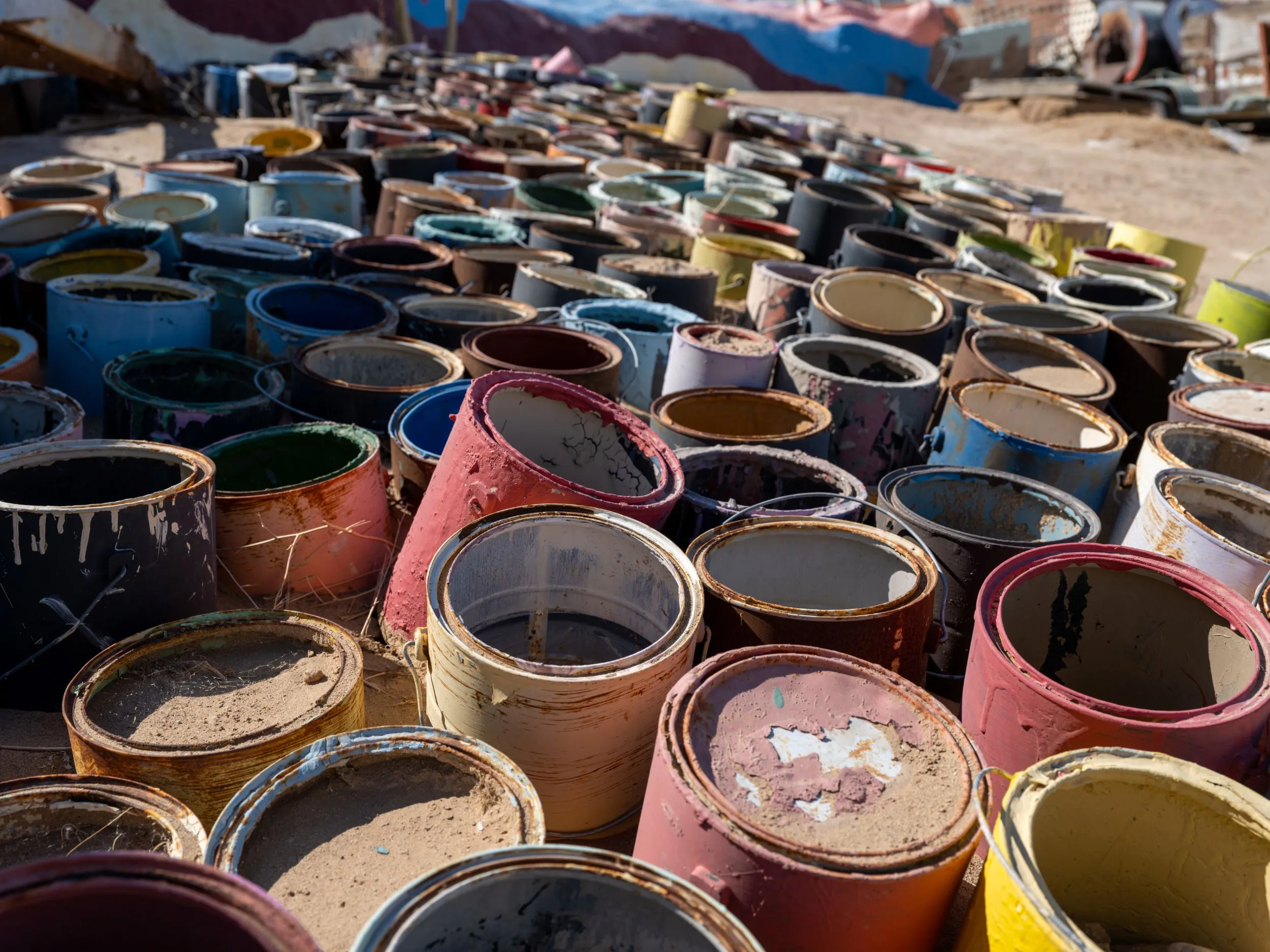Demand for paints continues to rise in both the residential and industrial sectors. While the COVID-19 pandemic had a serious impact on the global paint industry due to supply chain disruptions and pauses in construction projects, conditions have since improved and the industry has recovered from the event, reaching pre-pandemic levels of demand and supply. The growth of urbanization and the burgeoning industrial sector in Asia-Pacific and beyond are fueling demand for interior, exterior, and industrial paint products, and the market’s value is rising.
However, this much paint demand and production also results in significant energy production and in plastic and chemical waste. Governments around the world are seeking to reduce their countries’ environmental impact, and the concept of a circular economy is becoming increasingly important. New regulations and agreements are being put in place, and consumers are making their purchase decisions in part based on a company’s social responsibility. Because of this, many paint industry companies are beginning to research and implement more sustainable processes and products.
What is a Circular Economy?
A circular economy is essentially one that generates no waste. Instead of sending materials to the landfill when they have reached the end of their useful life, these items are kept in the system through processes such as maintenance, recycling, reuse, refurbishing, or composting. Whether they become part of the same kind of product or are used in a completely different industry, these materials are once again put to use, reducing the amount of trash created as well as the need for virgin resources. This cuts down on activities such as mining and deforestation, reducing reliance on finite resources and allowing renewable resources more time to replenish. It also reduces the amount of emissions released into the atmosphere from activities such as collecting, refining, and transporting these resources.
Also important to a circular economy are products that are long-lasting, reducing the need for new products and therefore also the need for more resources. Circular economy products are designed in ways that allow them to easily be reused, fixed, or disassembled.
Support for Circularity
A circular economy may seem like a lofty goal, but many organizations are already well on their way, encouraged and supported by government initiatives and research by institutions around the world. The EU, for example, adopted the first Circular Economy Action Plan (CEAP) in 2015 and, having begun or completed every action under the plan, adopted a new CEAP in early 2020. The plan is an important building block in the European Green Deal, an initiative to make the EU more sustainable, and a necessary step towards the EU’s the EU’s 2050 climate neutrality target.
The current CEAP targets the full life cycle of products, from design to production to end of life. It encourages sustainable production and consumption and aims to prevent waste. The plan includes both legislative and non-legislative measures, and focuses on sectors that use the most resources and have the most potential for circularity, such as packaging, electronics, construction, vehicles, and more.
Circularity in the Global Paint Industry
The global paint industry also has potential for circularity, and initiatives such as the EU’s CEAP are helping to drive and support this. Several companies are already developing and producing circular products, as well as products with significantly lower emissions and waste. They are also working to make their manufacturing processes more efficient, saving on both money and other resources.
Reducing waste is an important function of a circular economy. In Britain alone, for example, 5.76 million tonnes of paint is thrown away each year, and only 2% of leftover decorative paint is reused or recycled. Some paints also contain volatile organic compounds (VOCs) that are dangerous to the health of humans and animals, and if waste isn’t handled properly this can cause significant damage to the environment and risk to people. Because of this, companies are increasingly manufacturing and using paints with few or no VOCs, but paints with higher levels are still an issue.
Paint waste also contains an expensive mineral, titanium dioxide (TiO2), which costs almost $4,400 per tonne. TiO2 production consumes high amounts of energy and creates a lot of emissions. Reclaiming this mineral from waste paint is therefore beneficial to both manufacturers and the environment. In addition, a significant amount of the global paint industry’s carbon emissions come from raw material manufacturing and paint disposal. A circular economy can dramatically reduce both of those.
A circular economy can also help companies deal with resource shortages and cost fluctuations. Early in the pandemic things were particularly challenging with regards to raw materials, and the Russia-Ukraine war has also been disruptive: resource, energy, and shipping costs have risen and the supply chain continues to struggle. This means acquiring enough resources to meet demand can be both difficult and expensive.
A circular economy avoids some of these pitfalls. Increasing efficiency and reducing waste during the production process means that more product is created from the same amount of resources. Reusing and recycling old products means that a company is less reliant on new raw materials. These repurposed materials can often be less expensive than virgin raw materials and not as subject to price fluctuations. Depending on the type of resource and its location, they may also have lower transportation costs. All of this results in cost savings and greater resiliency in the face of supply chain disruptions and high material prices.
Recycling Paints
Water-based and latex paints can be recycled into new paint products or used in other products such as cement. Oil-based paints can be used for power generation. But before recycling, reuse is also an important strategy. The average shelf life of decorative paint is 10 years, meaning there’s much opportunity for unfinished cans of paint to find new homes. There are many initiatives around the world to facilitate the collection and redistribution of paints, and some will also filter and remix them into new paints.
Pigging Systems in the Paint Industry
One step towards a circular economy is the adoption of pigging in paint manufacturing facilities. Pigging systems involve a pig: a specialized device designed to fit inside a pipeline. The pig travels through the pipeline to recover residual liquid product. Not only does this increase product yield and reduce waste, it also lowers water usage and production downtime, makes the pipeline cleaning process more efficient, and cuts down on energy consumption and emissions.
Reducing Packaging Waste
Packaging is an important part of a circular economy, and companies are increasingly developing new recyclable and biodegradable packaging options to suit a variety of substances and needs. For example, BASF offers a water-based acrylic dispersion Joncryl High-Performance Barrier (HPB), which has vapor and water resistance and can replace plastic packaging and improve the recyclability of paper-based packaging.
One of the companies taking advantage of this product is Nippon Paint China, which is using it for the company’s dry-mixed mortar series of products. This is expected to save thousands of tonnes of plastic and reuse over 9,000 tonnes of paper bags.
Dulux Paints and Coatings is taking a different tactic to reduce paint packaging waste in Australia. Its Dulux Project Earth Circular Plastic Recycling Program collects used plastic pails and tear strips pails, granulates them, and makes them into new plastic products for the paint industry such as roller trays, stirrers and painter pots. The program has already recycled over 25 tonnes of paint pails, and construction companies and contractors that take advantage of it don’t need to pay to throw away paint pails and drums that would normally go to landfills.
A Fully Circular Paint Product
German company PNZ Woodcare Manufactory has partnered with Zentek Group to produce paint and packaging that are both sustainable. “Wandfarbe ohne Abfall“ (Wall Paint Without Waste) is a solution that uses a silicate wall paint and reusable container. Silicate wall paint contains no biocides and is breathable and mold-inhibiting. It’s long-lasting and manufactured from regional resources.
The bucket it’s sold in is made from HDPE and allows paint to be rolled directly from it. When the user is done with it, the bucket can be shipped back to the manufacturer for free and does not need to be cleaned first. The company cleans the buckets with pressurized water and then dries the cleaning water to reclaim the paint residue (which consists mostly of chalks and Ti02) and uses it to manufacture new paint. The buckets can be used 12-20 times, and when they reach the end of their life cycle, are shredded and used to manufacture rHDPE, which can be made into new packaging or other products.
Compared to existing single-use polypropylene buckets, this system reduces carbon emissions by 90% and microplastics by 100% due to the methods used to recycle the buckets.
While many of these products and recycling systems are still in the early stages and not widely adopted around the world, they are quickly growing in number. Government regulations and international agreements are providing both pressure and support, and consumers are increasingly demonstrating that there is demand for sustainable products. The potential financial and logistical benefits are also helping to encourage the development and adoption of circular economy practices in the global paint industry.



